|
|
Steeplechasing Notes
 |
°Steeplechasing has its roots in "pounding matches" held in Ireland in the late 17th century; matches held across haphazardly chosen country until the loser was "pounded" into the ground by being out-lasted by the winner, or fell. Horses were typically heavy animals who could handle rough ground, stay, and jump.
°By the mid-18th century chosen courses with a terminating winning post of a pre-agreed upon landmark, often a church steeple or tower, were more typical than not. Thus, the word "steeplechase," although the term "steeplehunt" was apparently the original term used. Many authorities cite a 1752 match over four and one-half miles from Buttevant Church in Co. Cork to the spire of St. Leger Church, between a Mr. Edmund Blake and a Mr. O'Callaghan, as one of the first of these more recognizable types of races. A draft of conditions for an Irish steeplechase race held in 1803, "...a sweepstake with added money of a hogshead of claret, a pipe of port and a quarter-cask of rum," and the use of the word "steeplechase" in the Irish Racing Calendar of 1807, to describe a six mile cross-country match race, help bracket the use of the term. |
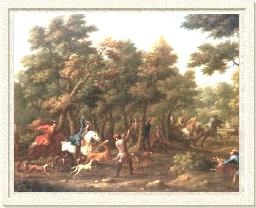
A stag hunt, c. 1740. By John Wootton.
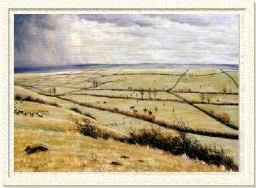
The open country of Leicestershire. By Geoffrey Giles, c. 1895. |
|
°In England, as the Industrial Revolution began to to consume forests, which supported deer populations, the British aristocracy turned from stag hunting to fox hunting, which apparently proved to be more exciting in any case. Charles, the second Duke of Grafton established a (fox) hunting pack of hounds at Wakefield Lodge sometime around 1715, and was such an enthusiast of the sport that King George II commented in 1735 that it was "...a pretty occupation" for a man of quality and of his age to hunt a poor fox [Grafton was age 52 at the time]." It became clear that slower horses who were not required to jump much, nor show much speed, were inadequate to keep up with faster prey that would race across open country.
°Initially English fox hunts were a matter of running down the fox, in a battle of attrition through heavy country, but the notion of chasing foxes at speed across open grazing country enclosed by hedges, stone walls, irrigated by ditches, caught on. Lightly wooded Leicestershire, with its vast enclosures offering good open runs, became a fashionable location, and horses who could run fast and jump handily became the mounts of choice.
Thoroughbred sires were increasingly crossed on grade mares of various types; one such example is the fourth Duke of Grafton's decision to send one of his well-bred thoroughbreds, Pioneer (1804, Whiskey - Prunella) to Wakefield Lodge to serve as a hunter sire for his mares, and those belonging to his tenants. The notion of matching these faster hunters against each other, without the fox, was irresistible. |

Dick Christian in Melton Mowbray, 1841. By John Ferneley, Sr.
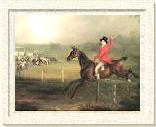
John Spence and Fugitive clearing the last hurdle at Bedford. By C.H. Schwanfelder, 1817. |
|
°Dick Christian (1779-1862), one of a number of chasing/hunting characters with roots in Melton Mowbray, rode in steeplechases during the first few decades of the 19th century for owners such as Lord Plymouth, Berkeley; Craven and Lord Forester. One of his races was a match between Clinker, who Christian rode for White and Ross, and Clasher, ridden by George Osbaldeston; Christian's description of the race was recorded by The Druid in Post and Paddock... "he was such a good one at rails was Clincker; I thought he was winning, but deary me, down he comes at the last fence, dead beat..." Christian described the ideal hunter as one who had "great rump, hips and hocks, forelegs well afore him and good shoulders, but none of your high short horses."
Generally, in Ireland, thoroughbreds, or at the very least thoroughbred sires, were considered essential in breeding hunters and chasers. Through judicious crossing of mares who were not completely thoroughbred--or who at least could not be traced back to foundation mares listed in the General Stud Book-- a number of half-bred mare families were established, especially in Ireland. They have provided steeplechasing with some of its greatest winners.
° Matches across country were held in both England and Ireland, from the mid-eighteenth century. One of the earliest recorded matches in England was in 1790, between Mr. Loraine Hardy and Hon. Mr. Willoughby's horses for 1,000 guineas over nine miles, from Melton Mowbray to Dalby Wood. None of these early matches, from "point to point," had a course set--the rider was free to select his own course to the winning post. Later, flags were occasionally placed along the agreed-upon course to be followed. In an 1813 match in Co. Roscommon Ireland, over six miles, the obstacles included "...six walls five feet high and several yawning ditches."
|
°The first known steeplechase course,as opposed to a race across country, to be laid out in England was in 1810 at Bedford, a three mile course with eight fences, 4' -6" high. Horses entered in this hurdle race had to be certified hunters.
° As the number of steeplechase races increased, both in England and Ireland, so did the frequency of evils perpetuated during the running; out in the country, rivals would run into interference from a favorite's supporters; holes in fences would appear to ease a fancied horse's way, and other abuses were common. In this, 'chasing was not unlike its sister sport, flat-racing at this time. For this reason, and others, many of the establishment racing community and in the fox hunting community, particularly in England, did not favor steeplechasing: Charles Apperley ("Nimrod"), the first influential turf writer, considered it dangerous to man and horse; others opposed to it during the first half of the 19th century included prominent members of the Jockey Club, such as Admiral Rous, the "dictator of the English Turf." Finally, the Grand National Hunt Committee was formed to control the sport and assess penalties. It was recognized by the Jockey Club in England in 1866; in Ireland the Irish National Hunt Steeplechase Committee was formed in 1869 to perform the same tasks.In 1889 The Grand National Hunt Committee's name was changed to the National Hunt Committee, by which it is known today.
|
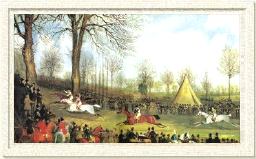
St. Albans Grand Steeplechase, 1834. By James Pollard.
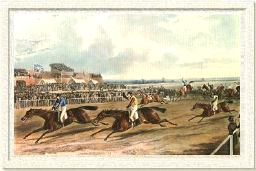
The Grand National running of 1839 at Aintree, Lottery in the lead. By F.C. Turner. |
|
°1830 was the inaugural year of the St. Albans steeplechase, near London, which proved to be highly popular with the public. The following year was even more successful, four miles cross country with horses carrying 11 st. 7 lb.; it was won by a famous early steeplechaser, Moonraker, owned by Mr. Beardworth, who also won the St. Leger that year with his horse, Birmingham.
St. Albans is significant for its influence on the establishment of other steeplechase meets elsewhere in England. A decade later, there were more than sixty held in various parts of England.
°The first flat-race meeting held at Aintree, near Liverpool, was in 1829. In 1836, the Liverpool Grand Steeplechase was first held there; the course included twenty fences in two circuits. It was significant in that the course was enclosed and the fences were flagged along the route. It was held again, under slightly different conditions and with the name The Liverpool Steeplechase, in 1837-38, and some people date the commencement of the Grand National from these dates. Others consider the first true running of it to be 1839, when a syndicate of trustees comprised of prominent turfites took over the management of the race from the original lessee of the land at Aintree and operator of the course, Mr. Lynn, owner of the Waterloo hotel. It was originally called the Grand Liverpool Steeplechase, changed to the Liverpool and National Steeplechase in 1843, and finally, the Grand National in 1847. |
° In Ireland, steeplechasing was an on-going feature of racing meetings, primarily in the west. In the 1830s courses were laid out at Mayo, with graded obstacles and weight based on age; at Ballinrobe, at Tuam, at Cashir, and elsewhere. Still, the actual route of travel to the final flag was left to the rider. In 1854 the first regular steeplechase meeting, which included the race for The Corinthian Cup, was held at Punchestown; the racing here was over a defined circuit. In 1861 the Punchestown Races were reorganized as The Kildare and National Hunt Steeplechases, permanent stands and enclosures were constructed; the Conyngham Cup course was opened and used first in 1862 for the National Hunt Steeplechase. Fairyhouse, near Dublin, and the Ballybrit course near Loughrea, site of the Galway Plate, also were established in mid-century; the 3 mile-5 furlong Irish Grand National was inaugurated in 1870 at Fairyhouse.
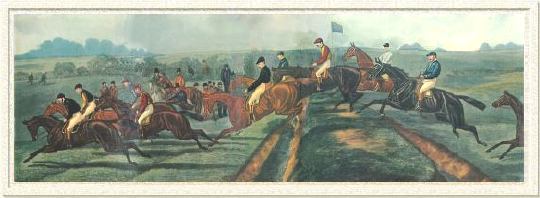
The Conyngham Cup of 1872, at Punchestown in Ireland, won by Heraut d'Armes. The famous "Double," a 6 foot-6 inch wide and 3 feet deep first ditch, the top 6 foot-6 inch wide, the second ditch 4 feet wide. By John Sturgess.
° The first steeplechase at Cheltenham was held in 1841. Because Lottery (winner of the 1839 Grand National) won it, he was required to carry the incredibly heavy weight of 13 st. 4 lbs. in his 1841 race at Aintree, where he was pulled-up by his rider, the famous Jem Mason. Steeplechases were run in and around Prestbury park for many years; the present course where the Cheltenham Gold Cup (steeplechase--a flat race with that name was run in the vicinity over 100 years ago) is run was laid out in 1902. It became the permanent venue for the four mile National Hunt Steeplechase, then open only to maidens ridden by amateurs, in 1911. In 1924 the Chelteham Gold Cup was instituted, to offer a chance for long-distance chasers to compete against each other under level terms in a weight-for-age race. At first it was considered a training race on the way to the Grand National, but has since become a prestigeous race in its own right, now recognized as the championship of steeplechasing. |
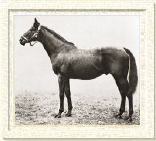
Wrack won flat and hurdle races in Britain; exported to the U.S. he became a leading sire of flat racers.
|
|
°Hurdle races in England date back to the early 19th century, if not earlier. One story has it that they became popular after, for amusement, George, Prince of Wales, Mrs. Fitzwalter, and some soldiers raced over sheep hurdles on the Downs near Brighton around 1808. By 1882 hurdle race courses were required to be at least 2 miles in length, with at least eight flights of hurdles, the hurdles to be no less than 3' 6" in height. In 1927 the Champion Hurdle race was established to provide a venue for top hurdlers. Both in England and on the continent, horses that did poorly on the flat were often tried over hurdles. Then, as now, the few horses that show a special aptitude for jumping are moved on to steeplechases, but most of these former flat racers succeed only at hurdling. |
Wrack (1909, Robert le Diable - Samphire) did well on the flat, and then won over hurdles, winning six of seven outings, before export to the U.S. and his place in history as a good sire of flat racers in the U.S. (leading sire by number of winners in 1923, 1930, 1931). His son, Petee-Wrack sired American Grand National winner Brother Jones, and Maryland Hunt Cup winners Peterski and Pine Pep.
°Up until 1882 the number and types of obstacles to be jumped in steeplechases in Great Britain were left to the whim of the course organizers. The National Hunt Committee regularized this, specifying the number of fences required for races of various lengths, and the minimum number and type of jumps.
° Point-to-Point race meetings began around 1880; unlike the increasingly regularized steeplechases and hurdle races, in point-to-points the object was to get to the finish over four miles of open country in the fastest time possible; the course route was left to each individual rider. In addition, the races were designed for horses that hunted, ridden by amateurs, although professionals began to take part in increasing numbers. In 1913 the Master of Hounds Point-to-Point Association was established to govern the meets, and 1937 point-to-points were brought under the rubric of the National Hunt Committee, which does not allow professional riders in these races. They serve as a source of income for local hunts and as a training ground for both horses and riders--Cheltenham Gold Cup and Grand National winners, such as Teal, Merryman II, Four Ten, and The Dikler, all started as point-to-pointers. |
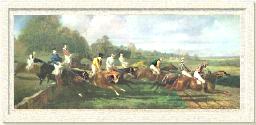
Top french jockeys, "cracks," a number of them aristocrats, commemorated by Pichot in a cross-country chase at Vincennes in 1865. |
|
°French steeplechasing was heavily influenced by young French gentlemen exposed to the sport in England. Cross-country matches of the "English type" were held in the late 1820s near St. Germain, and courses au clocher[races to the steeple] started to appear in race programs in the 1830s and '40s, largely contested by gentlemen-riders and cavalry officers of the aristocratic class. Obstacles were initially as challenging as those in Great Britain, and French owners and breeders even sent some chasers to Aintree to compete in the Grand National--one, Lutteur III, won it in 1909, and the 1865 winner, Alcibiade, was bred in France. |
The Société des Steeple-Chases de France was founded in 1863 to regulate chasing and, as in England, to attempt to control abuses. A little more than a decade later the racecourse at Auteuil, in Paris, was built as a venue for 'chasers and hurdlers. Both the Grand Steeple-Chase de Paris and the Grande Course des Haies d'Auteuil were established there in 1874. The course follows a figure eight form requiring horses to run in both directions, and the brush fences, while large, are comprised of soft privet, designed to be jumped through, rather than over.
Today, in both France and Italy, horses that fail on the flat at age 2 are often reschooled to jump hurdles at 3, and there are hurdle races throughout the country exclusively for 3 or 4 year olds, although the trend towards jumping 3 year olds seems to be slowing now. Average prize money for these races is higher than in Great Britain, which encourages owner and trainers to send their less-likely flat horses to jumping school. Speed is an essential component of these races, with only moderate jumping ability where horses jump from the forehand. Those with the conformation, ability to use their hind ends, and stamina are trained on to steeplechases. There have been a number of French-bred and/or trained winners of the Cheltenham Gold Cup, King George VI Steeplechase at Kempton, and important hurdle races in England in the past thirty years-- some of the top ones are half-bred or AQPS (Autres de que Pur Sang)-- but none have succeeded in the Grand National. French chasers have also frequently raided into Italy, winning the Gran Premio Merano.
|

Jerome Park water jump, 1877. Print by Currier and Ives. | 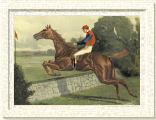
| | Kentucky-bred Trouble was trained in Canada; brought back to the U.S., he won the Grand Steeplechase Handicap at Jerome Park twice. |
|
|
°In the U.S., steeplechasing was introduced by the Washington Jockey Club in a race in Washington D.C. in 1834. After the Civil War, steeplechasing became a regular feature at Jerome Park in New York, and for a time it became a minor American obsession. Steeplechase and hurdle races and courses were established on tracks across the country, from San Francisco to Louisiana, some of which lasted up through the first World War. In 1895 the National Steeplechase and Hunt Association was formed to regulate the sport; in 1899 the American Grand National Steeplechase was first held over 2 1/2 miles at Morris Park.
The Agnew-Hart anti-gambling bill, passed in New York in 1908, impacted racetracks across the country, and steeplechasing, along with flat racing was dealt a serious blow as tracks such as Brighton Beach were sold, and Saratoga closed. In the interregnum, steeplechasing was kept alive at local hunt meets and "betless" meetings at tracks such as old Belmont; when racing resumed across the country, many tracks were rebuilt, old ones permanently closed, and new ones erected without steeplechase courses. In the 1920s and '30s chasing was dominated by a few wealthy patrons and amateur jockeys and trainers. |
By 1940 only Belmont Park, Saratoga and Acqueduct actually had steeplechase courses, and sanctioned chases with portable jumps were operating only in New York, Maryland and Delaware (the latter due to the efforts of wealthy 'chasing fan William du Pont). With the institution of pari-mutuel betting in 1941, Saratoga, and then Belmont reintroduced hurdle racing, which proved popular with the betting public and, more significantly, with professionals who could school a horse quickly over the lower fences, and eventually stakes races with decent money were offered, among them the New York Turf Writers race, the National Hurdle, and others. In 1974 jumps of packed pine or cedar were replaced by synthetic steeplechase fences made of a steel frame, foam-rubber and plastic "brush" with a 52 inch height--these portable "National Fences" are standard for more than 150 hurdle races held in the U.S. today.
After the World War II, hunt racing resumed with increased support as well, with important amateur races at Fair Hill, Maryland, and Rolling Rock in Pennsylvania. The Maryland Hunt Cup (established 1894) and the Virigina Gold Cup (established 1923) are timber races that have been supported by generations of local hunt families, and are the closest type of race today to the Grand National, albeit they are held over open ground, and not a turf course. The Maryland Hunt Cup is considered the toughest test of horse and rider in the U.S., with twenty-two solid natural obstacles, mostly tall, difficult to jump, vertical post and rails, across 4 miles of undulating terrain with varying types of footing; two winners of the race, Ben Nevis II and Jay Trump, have gone on to win the Grand National in England. In this race there are a number of winners that trace back to American foundation mares, including the aforementioned Jay Trump. |
|
|

